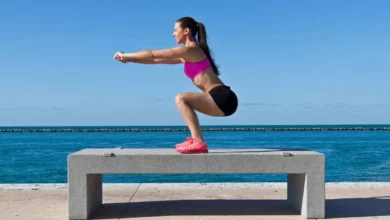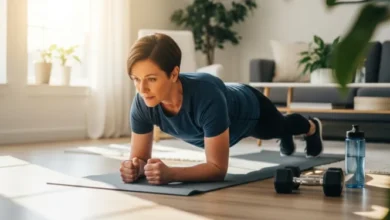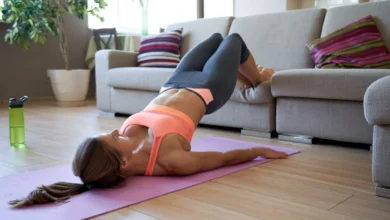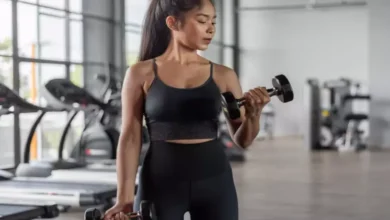Pilates for Beginners: 4 Simple Home Exercises to Boost Strength and Well-Being
pilates for beginners at home
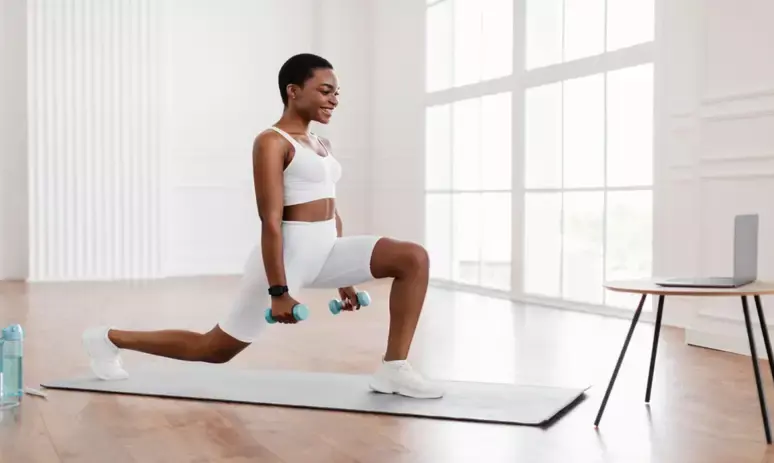
Many people believe that practicing Pilates requires specialized studios or expensive equipment, but that’s not the case. With a few simple exercises, you can start training at home and experience real benefits: increased flexibility, a stronger core, improved posture, and reduced stress.
READ ALSO:
- Apple Carrot Blueberry Juice: A Nutritious Drink for Energy and Wellness
- 3 Shakes for Rapid Muscle Growth: Vitamins for Fast Hypertrophy
Follow our PAGE
Key Benefits of Pilates for Beginners
Pilates combines controlled movement with mindful breathing. This means that every exercise requires body awareness, proper alignment, and concentration. As a result, it not only strengthens the muscles but also enhances posture, reduces tension, and helps prevent pain caused by daily sedentary habits.
For anyone who spends long hours sitting — whether studying, working, or using screens — Pilates is especially helpful. It activates muscles that tend to weaken over time and teaches the body how to maintain a neutral, healthy posture. The focus on breathing also promotes relaxation and mental clarity.
Pilates for Beginners at Home: Essential Exercises
Below are four beginner-friendly movements you can perform at home with minimal space and equipment.
1. Diaphragmatic Breathing
- Starting position: Sit with your spine upright and your hands resting on the lower rib cage.
- Movement: Inhale deeply through your nose, expanding the rib cage and abdomen. Exhale slowly through your mouth while gently engaging the abdominal muscles.
- Repetitions: 8 to 10 slow breathing cycles.
This foundational exercise improves breathing awareness, warms up the core, and prepares the body for more dynamic movements.
2. Hamstring Stretch Using a Strap
- Starting position: Lie on your back with one leg extended on the floor and the other raised, supported by a strap (or a towel).
- Movement: Pull the strap gently toward you while keeping the lower back grounded. As you exhale, extend the knee, feeling a controlled stretch along the back of the thigh.
- Repetitions: 8 to 10 on each leg.
This stretch enhances flexibility, releases tension, and improves mobility in the hips and lower back.
3. Cat Stretch
- Starting position: Position yourself on all fours with hands under shoulders and knees under hips.
- Movement: Inhale keeping the spine neutral. Exhale and lift your spine upward, rounding the back like a cat. Bring the chin toward the chest. On the next inhale, return to a neutral spine while keeping the core active.
- Repetitions: 8 to 10 slow and controlled rounds.
This movement mobilizes the entire spine, relieves stiffness, and helps improve posture.
4. Wall Roll Down
- Starting position: Stand with your back against the wall, feet slightly forward, and arms relaxed by your sides.
- Movement: Inhale and lengthen the spine. Exhale and roll down gradually, allowing the head and spine to flex one vertebra at a time. Let the arms hang loosely. When rising, engage the core and unroll the spine slowly, stacking each vertebra until the head comes up last.
- Repetitions: 8 to 10.
This exercise increases awareness of spinal articulation, strengthens the core, and helps correct postural imbalances.
How to Include Pilates in Your Weekly Routine
If you’re just starting, practicing 2 to 3 times per week is ideal. Sessions can be short—15 to 20 minutes are enough to feel improvement when done consistently.
Tips to build consistency:
- Choose a calm time of day (morning or evening) and stick to it.
- Use soft background music to create a pleasant environment.
- Practice on a yoga mat or soft surface for comfort.
- Progress slowly: increase repetitions only when you feel stable and confident.
Pilates is not about speed. It’s about precision, breathing, and focus—qualities that grow with practice.
Precautions Before You Begin
While Pilates is gentle and accessible, it’s important to stay mindful:
- Never push past your comfort zone. Pain is a sign to stop.
- Keep breathing fluid throughout every exercise.
- If you feel persistent discomfort, rest and consider professional guidance.
- Start slowly and allow your body to adapt naturally.
Final Thoughts: Pilates at Home Is for Everyone
With just four simple movements, you can begin your Pilates journey at home and feel significant improvements in strength, mobility, and mental well-being. No special equipment is required—only commitment, consistency, and awareness.
By practicing regularly, you’ll notice increased stability, better posture, reduced tension, and a more relaxed mind. Pilates is a powerful tool for health, and the best part is: anyone can start right now without leaving home.

Hello! My name is Alan Teixeira and I am passionate about helping people live healthier, more balanced lives. From mindful eating to daily habits that promote physical and mental well-being, I believe that small, consistent changes can lead to powerful transformations.
I created this blog to share practical tips, reliable information, and thoughtful insights that can inspire you to take better care of yourself—with balance, mindfulness, and positivity.
If you are looking to improve your health, nourish your body, and build a lighter, more fulfilling routine, you are in the right place. Welcome!

